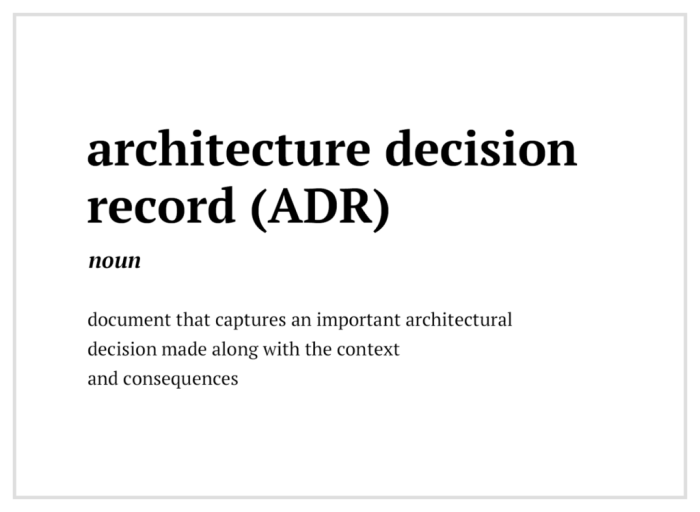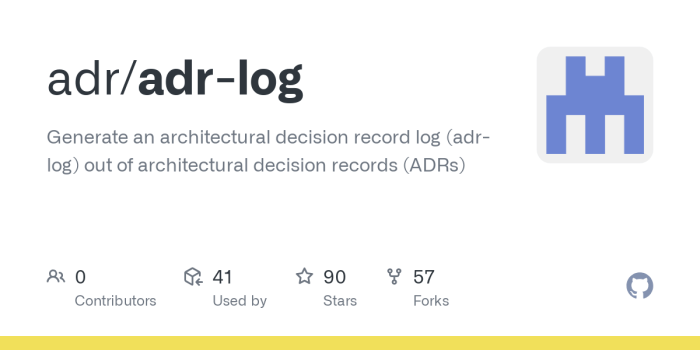Understanding architectural decision records (ADRs) is crucial for any software development team aiming for maintainable, scalable, and consistent projects. ADRs provide a structured way to document and track important design choices, enabling better collaboration and knowledge sharing among team members.
An ADR serves as a living document, recording the rationale behind architectural decisions. It captures not only the decision itself, but also the context, considerations, and potential trade-offs. This approach ensures transparency and accountability in the design process, ultimately leading to a more robust and adaptable software architecture.
Key Elements of an ADR
Architectural Decision Records (ADRs) are crucial for maintaining transparency and traceability in software development. They document important decisions made during the design and implementation phases, enabling better understanding, easier maintenance, and quicker resolution of potential issues. A well-structured ADR ensures that future developers and stakeholders can grasp the reasoning behind choices, facilitating collaboration and minimizing rework.
Essential Information in an ADR
ADRs should include comprehensive information to facilitate understanding and future reference. This encompasses details like the context surrounding the decision, the specific decision itself, and the rationale behind it. A complete record promotes clarity and allows for informed decisions in future iterations.
- Context: Clearly define the problem or situation prompting the decision. This includes the relevant background information, the goals, and constraints that influenced the decision.
- Decision: Articulate the specific choice made. The decision should be unambiguous and clearly stated. Avoid ambiguity or vagueness.
- Rationale: Provide a detailed justification for the decision. This explanation should highlight the factors considered and the reasoning behind selecting the chosen approach. This could include trade-offs, potential impacts, and alternative solutions.
- Alternatives Considered: Listing and evaluating alternative solutions provides a complete picture of the decision-making process and strengthens the rationale.
Actionable ADRs
An actionable ADR is one that provides enough information to allow developers and stakeholders to understand the decision and potentially implement or use it. This requires precise language and a structured format.
- Specific and Measurable: The decision and rationale should be specific enough to avoid misinterpretations. Using quantifiable metrics (where possible) enhances clarity and allows for future evaluations of the decision’s impact.
- Clearly Defined Impact: The ADR should clearly Artikel the anticipated effects of the decision. Positive and negative consequences should be addressed to promote transparency and accountability.
- Practical Considerations: The ADR should include any practical aspects, such as technical implementation details, or potential dependencies. This practical aspect increases the likelihood of successful implementation.
Versioning and Revision History
Maintaining a clear version history is essential for tracking changes to an ADR. This helps to understand the evolution of the decision and the reasoning behind modifications. Version control ensures accountability and facilitates the review of past decisions.
- Version Control System: Employ a version control system (like Git) for ADRs to track changes, revisions, and authors. This facilitates easy access to previous versions and their reasons for modification.
- Revision History: Each revision should be accompanied by a brief description of the changes made and the reason behind them. This promotes traceability and transparency, allowing stakeholders to follow the evolution of the decision.
Stakeholder Identification
Identifying stakeholders is critical for ensuring the ADR reflects the needs and concerns of all relevant parties. This proactive approach minimizes potential conflicts and promotes consensus.
- Comprehensive List: Create a comprehensive list of stakeholders impacted by the decision, including developers, designers, testers, and clients.
- Consideration of Interests: Understand the potential impact of the decision on each stakeholder’s interests. This promotes a more inclusive and collaborative approach.
Example ADR
| Context | Decision | Rationale |
|---|---|---|
| The current user interface (UI) for the application is difficult to navigate, especially for new users. User feedback highlights the need for improved clarity and ease of use. | Implement a redesigned UI with a simplified navigation structure. | The existing UI has been found to be confusing and counter-intuitive. The new UI will improve usability and user satisfaction, reducing support requests and improving overall customer experience. Alternative designs were evaluated, and the chosen solution provides the best balance between user-friendliness and technical feasibility. |
ADR Lifecycle and Management

Architectural Decision Records (ADRs) are valuable artifacts for documenting and communicating important design choices. Effective management of ADRs throughout their lifecycle is crucial for maintaining consistency, transparency, and a shared understanding within a development team. This section details the typical lifecycle of an ADR, outlining the process for managing them and highlighting the roles of the ADR author and reviewers.
ADR Lifecycle
The typical lifecycle of an ADR progresses from initial creation to eventual archiving. A well-defined process ensures that ADRs remain relevant and easily accessible throughout the project’s duration. This structured approach promotes traceability and accountability.
- Creation: The ADR is initiated by an author when a significant architectural decision is made or contemplated. Clear documentation of the decision, rationale, alternatives considered, and impacts is paramount.
- Review: After creation, the ADR is reviewed by relevant stakeholders. This phase is critical for identifying potential issues, verifying the accuracy of the information, and ensuring alignment with the overall project architecture.
- Approval: Once the review process is completed and any necessary adjustments are made, the ADR is approved. This signifies that the decision is accepted and understood by the team.
- Implementation: The decision documented in the ADR is implemented. This phase necessitates careful consideration and adherence to the documented plan.
- Monitoring and Evaluation: Post-implementation, the effectiveness of the decision is monitored. This phase helps identify unforeseen consequences or areas for improvement.
- Archiving: After a defined period, or when the decision is no longer relevant, the ADR is archived. This ensures that historical decisions remain accessible while not cluttering current work.
ADR Management Procedure
A well-defined procedure for managing ADRs within a team fosters transparency and ensures consistency. A standardized approach guarantees that all decisions are documented, reviewed, and tracked effectively.
- Centralized Repository: ADRs should be stored in a centralized repository, accessible to all relevant team members. This ensures that all team members have access to the decisions made and rationale behind them.
- Version Control: Implement version control for ADRs. This allows for tracking changes, identifying who made modifications, and reverting to previous versions if necessary. This is vital for maintaining a clear history of decisions.
- Review Process: Establish a clear review process with defined roles and responsibilities for reviewers. This fosters collaboration and ensures a thorough assessment of the ADR.
- Regular Review and Update: Schedule regular reviews of ADRs to ensure they remain relevant and up-to-date with evolving project needs. Regular checks guarantee decisions continue to align with current priorities.
Role of ADR Author and Reviewers
The roles of the ADR author and reviewers are distinct yet interdependent. Each plays a critical part in ensuring high-quality documentation and informed decision-making.
- ADR Author: The author is responsible for creating a comprehensive ADR. This includes documenting the decision, rationale, alternatives, and impacts. They must clearly articulate the implications of the decision and ensure clarity for all stakeholders.
- Reviewers: Reviewers critically evaluate the ADR for accuracy, completeness, and alignment with the overall architecture. Their feedback helps refine the ADR and ensures a well-informed decision.
ADR Review Process Flowchart
[Note: A flowchart illustrating the ADR review process would be visually represented here. It would depict steps such as creation, review request, review, feedback, revision, approval, and archiving.]
Ensuring ADR Relevance Over Time
ADRs should be periodically reviewed to ensure they remain relevant and accurate. The frequency of these reviews depends on the project’s complexity and the rate of change. This approach maintains the value of ADRs as project requirements evolve.
- Regular Review Cycles: Implement regular review cycles for ADRs. This could be quarterly, semi-annually, or annually, depending on the project’s pace and the stability of the architecture.
- Automated Alerts: Implement automated alerts to notify stakeholders when ADRs are due for review. This proactive approach helps maintain up-to-date information.
- Contextual Updates: When a significant change occurs in the architecture, consider updating the ADR to reflect the new context. This ensures the ADR continues to provide accurate and complete information.
ADR Templates and Examples
Architectural Decision Records (ADRs) are crucial for documenting and communicating architectural decisions. A well-structured template ensures consistency and clarity, aiding in understanding the rationale behind choices and facilitating future reference. This section details various ADR templates and examples, showcasing how to effectively use tables and formatting for improved readability.Using standardized templates and examples streamlines the ADR process, enhancing collaboration and knowledge sharing within teams.
This consistent approach fosters a shared understanding of the architecture and reduces ambiguity.
ADR Template
A well-designed ADR template provides a structured framework for documenting decisions. This template ensures comprehensive information is captured, facilitating efficient review and understanding. A template should include key elements, enabling clear communication and traceability of decisions.
- Decision ID: A unique identifier for the ADR, crucial for traceability and referencing.
- Date: The date the decision was made.
- Author: The individual responsible for the decision.
- Decision: A clear and concise statement of the decision made.
- Rationale: Justification for the decision, including considerations of trade-offs, constraints, and alternatives.
- Context: A brief overview of the situation prompting the decision, including relevant background information.
- Alternatives Considered: A list of alternative approaches evaluated and the reasons for rejecting them.
- Impact: Potential positive and negative impacts of the decision.
- Future Considerations: Potential implications for future decisions or changes to the architecture.
ADR Examples
These examples illustrate the application of the ADR template in different scenarios. Each ADR highlights a different aspect of architectural decision-making.
- Example 1: Database Choice
Decision: Select PostgreSQL as the primary database for the application.
Rationale: PostgreSQL offers excellent performance, features, and community support.
Context: High data volume and complex queries are anticipated.
Alternatives: MySQL, MongoDB.
Impact: Improved data integrity, better query performance.
Future Considerations: Potential scaling challenges if data volume exceeds projected capacity.
- Example 2: API Design
Decision: Adopt RESTful API design with JSON for data exchange.
Rationale: RESTful APIs are widely used, promoting interoperability and ease of integration.
Context: The application needs to interact with multiple external systems.
Alternatives: GraphQL, SOAP.
Impact: Facilitates communication with various systems.
Future Considerations: Potential for complexity if the API design is not carefully managed.
Using Tables for Organization
Tables can effectively organize information within an ADR, making it easy to compare alternatives and understand the decision-making process.
| Alternative | Performance | Cost | Scalability |
|---|---|---|---|
| PostgreSQL | Excellent | Moderate | High |
| MySQL | Good | Low | Moderate |
Structured ADR Example
The following example demonstrates a structured ADR, leveraging a blockquote for different sections.
Decision ID: ADR-001
Date: 2024-10-27
Author: John Doe
Decision: Implement a caching layer to improve application responsiveness.
Rationale: Extensive user testing revealed significant delays in data retrieval. A caching layer will significantly reduce latency.
Context: High user traffic and frequent data requests are expected.
Alternatives Considered:
- Optimize database queries
- Implement asynchronous data retrieval
Impact: Reduced response times for end-users.
Future Considerations: Monitoring cache performance and implementing cache invalidation strategies.
Formatting for Readability
Using bold text, bullet points, and clear headings enhances the readability of ADRs. This allows for quick comprehension and easy referencing of crucial details. Using consistent formatting creates a professional and easy-to-understand document.
ADRs and Communication
Architectural Decision Records (ADRs) significantly enhance communication within a development team by documenting important design choices. This transparency fosters a shared understanding of the rationale behind decisions, reducing ambiguity and potential conflicts. By outlining the considerations and trade-offs involved, ADRs provide a valuable resource for everyone involved in the project.
Improving Communication Within a Development Team
ADRs promote clear communication by recording the motivations and trade-offs behind architectural decisions. This detailed documentation minimizes misunderstandings and ensures everyone is on the same page. Team members can readily refer to ADRs to understand the context of specific choices, fostering a more collaborative and efficient workflow.
Referencing ADRs in Other Documents
Clear referencing of ADRs in other project documents is crucial for maintaining consistency and traceability. A consistent method for referencing ADRs, such as using a unique identifier (e.g., ADR-001), is essential for easy lookup and avoids ambiguity. This structured approach helps maintain a comprehensive record of design decisions and their rationale, ensuring everyone understands the basis for any subsequent modifications.
Examples of referencing include: “This approach aligns with ADR-003 regarding database schema design” or “Refer to ADR-007 for the rationale behind the API design.”
Resolving Disagreements Using ADRs
ADRs can be instrumental in resolving disagreements during the development process. By providing a documented record of the decision-making process, ADRs provide a neutral ground for discussion and facilitate a more objective evaluation of the various options. When disagreements arise, team members can refer to the ADR to understand the rationale behind the original decision and identify potential areas for improvement or alternative solutions.
Presenting ADRs in a Meeting
Presenting ADRs effectively in a meeting requires a concise and focused approach. Key elements to include are a brief summary of the decision, the rationale behind it, and any relevant alternatives considered. Visual aids, such as diagrams or flowcharts, can further enhance understanding and clarity. The presentation should encourage discussion and questions from the team members, fostering a collaborative environment.
When presenting, clearly state the ADR number, a brief description of the problem or decision, the decision itself, and the rationale.
Accessibility and Searchability for ADRs
ADRs should be easily accessible and searchable to ensure they are readily available to all team members. Centralized storage, along with a well-defined naming convention and s, enhances searchability. This facilitates quick retrieval of information, allowing team members to quickly find the documentation they need. The use of a shared repository, like a wiki or a dedicated ADR platform, ensures all team members can access the records.
A good search capability (e.g., by s, problem description, or decision) is essential for efficient retrieval. For example, searching for “database schema” might yield all ADRs pertaining to database design decisions.
ADRs and Decision Making
Architectural Decision Records (ADRs) play a crucial role in fostering informed decision-making within software development projects. By documenting the rationale behind architectural choices, ADRs provide a historical context that helps teams understand the trade-offs made and the potential implications of those choices. This transparency is invaluable when revisiting or modifying architectural designs in the future.ADRs facilitate a more deliberate and reasoned approach to decision-making.
By requiring explicit justification, they encourage a deeper understanding of the problem space and potential solutions. This detailed documentation mitigates the risk of poorly considered decisions by prompting careful consideration of the consequences and alternatives.
Contribution to Informed Decision-Making
ADRs contribute to informed decision-making by explicitly documenting the rationale behind architectural choices. This documented rationale enables teams to understand the trade-offs made and the potential implications of those choices. Furthermore, by outlining the assumptions and constraints underlying a decision, ADRs help avoid repeating past mistakes and allow for a more informed discussion of similar issues in the future.
Identifying Potential Problems with a Proposed Decision
ADRs provide a structured approach to identifying potential problems with a proposed decision. By forcing the decision-makers to document the rationale, assumptions, and alternatives, they encourage a more thorough examination of the proposed solution. This scrutiny helps reveal potential issues or unforeseen consequences that might otherwise be overlooked. A well-written ADR will clearly articulate the risks associated with the decision and propose mitigation strategies.
Tracking and Evaluating Architectural Decisions
ADRs serve as a centralized repository for tracking and evaluating architectural decisions. This repository allows teams to easily access and review past decisions, facilitating informed decision-making in the present and future. By documenting the rationale and outcome of each decision, teams can assess the effectiveness of past choices and identify patterns in successful and unsuccessful architectural strategies. The ability to track and evaluate decisions over time enables continuous improvement in the architectural design process.
Examples of Decisions Preventing Future Issues
ADRs have prevented future issues by providing a clear historical record of architectural decisions. For example, an ADR documenting the decision to use a specific caching mechanism might include the reasons for choosing that mechanism over alternatives, the anticipated performance gains, and potential risks. If future performance issues arise, the ADR provides a valuable reference point for understanding the context of the original decision and allows for a more informed discussion about potential solutions.
Another example involves a decision to adopt a microservices architecture. An ADR outlining the rationale for this decision, including anticipated benefits and challenges, can prevent future conflicts or misunderstandings regarding the overall system architecture.
Transparency in Decision-Making
ADRs promote transparency in decision-making by making the rationale behind architectural choices explicit. This transparency fosters a collaborative environment where team members can understand the motivations behind decisions and contribute to more informed discussions. By making the process of architectural decision-making visible, ADRs help build trust and consensus within the team. This transparency also enables easier onboarding for new team members who can quickly grasp the rationale behind existing architectural choices.
ADRs and Technical Documentation

Architectural Decision Records (ADRs) play a vital role in maintaining a consistent and well-documented architecture. They serve as a single source of truth for decisions impacting the system, and by linking them to technical documents, teams can ensure everyone understands the rationale behind design choices. This connection strengthens the overall understanding of the system and allows for more effective maintenance and evolution.ADRs significantly improve the quality and maintainability of technical documentation.
They provide a framework for recording the rationale behind decisions, enabling better understanding and collaboration among team members. This, in turn, leads to a more consistent and accurate representation of the system’s architecture in all relevant documents.
Linking ADRs to Technical Documents
ADRs should be explicitly linked to the technical documents they affect. This ensures traceability and helps teams quickly identify the decisions behind specific design choices. For example, if an ADR discusses a database schema design, the corresponding ADR ID should be included in the database design document. This creates a clear path between the decision and its implementation.
By including a concise reference, such as “See ADR #123 for details on database schema design,” teams can quickly find the rationale behind a specific design choice.
Improving Consistency of Technical Documentation
ADRs facilitate consistency by providing a central repository for architectural decisions. When teams refer to the ADRs before writing or updating technical documentation, they ensure that all descriptions align with the documented decisions. This minimizes inconsistencies and ensures a unified understanding of the architecture across all documents. The documentation becomes a more reliable source of information, improving the efficiency of the development process.
Maintaining a Shared Understanding of the Architecture
ADRs contribute to a shared understanding of the architecture by documenting the rationale behind choices. When technical writers, developers, and other stakeholders consult the ADRs, they gain a common understanding of the system’s design. This common understanding reduces ambiguity and improves communication, ultimately leading to more effective collaboration.
Relationships Between ADRs and Other Technical Documents
The following table illustrates the relationships between ADRs and common technical documents:
| Technical Document | Relationship with ADRs |
|---|---|
| Class Diagrams | ADR IDs can be included in class diagrams to link specific design choices to their reasoning. |
| Database Design Documents | ADRs related to database schema, data modeling, or other database design aspects should be referenced. |
| API Specifications | ADRs detailing API design choices, endpoints, and data formats should be linked to the API documentation. |
| Deployment Diagrams | ADRs outlining deployment strategies, infrastructure choices, or other deployment-related decisions should be referenced. |
| User Stories | ADRs related to user story requirements or technical considerations can be linked for context and clarity. |
Tracking and Managing Technical Debt
ADRs can be instrumental in tracking and managing technical debt. Each ADR documenting a work-around or suboptimal solution should explicitly identify it as such and describe the potential negative impacts. This allows teams to proactively address the debt by linking the ADR to tasks or projects dedicated to resolving the issue. This approach ensures that the trade-offs and implications of decisions are recorded, providing a clear path for addressing them in the future.
For instance, an ADR that describes a temporary solution to a performance bottleneck can be linked to a future task to optimize the system.
ADRs and Version Control
Architectural Decision Records (ADRs) are crucial for maintaining transparency and traceability in software development. Version control systems are essential for managing these records, ensuring that changes to decisions are documented and auditable. This approach allows for a clear history of architectural choices, which is vital for understanding the rationale behind current designs and for facilitating future modifications or retrofits.Effective version control for ADRs allows stakeholders to track the evolution of architectural decisions, enabling informed discussions and mitigating potential conflicts.
This crucial aspect of ADR management promotes a shared understanding of the architectural foundation, which is critical for successful project outcomes.
Importance of Version Control for ADRs
Version control systems provide a robust mechanism for tracking changes to ADRs over time. This historical record allows for a detailed analysis of the reasoning behind decisions, facilitating better understanding of the current architecture. It also serves as a valuable resource for future development teams, providing context and background for architectural considerations.
Tracking Changes to ADRs
Version control systems provide a complete history of changes made to ADRs. This includes details such as who made the changes, when they were made, and the specific content that was modified. These systems typically use a branching model to facilitate concurrent development and experimentation with alternative solutions. This historical record is invaluable for understanding the evolution of the architectural decisions.
Examples of Version Control Systems for ADRs
Common version control systems, such as Git, are suitable for managing ADRs. These systems allow for the creation of branches, enabling parallel development paths. This approach facilitates the exploration of alternative architectural designs without affecting the main line of development. The ability to revert to previous versions is a key advantage of using a version control system.
Using Comments and Annotations within an ADR
Comments and annotations within an ADR are crucial for providing context and explanations. Annotations can clarify the reasoning behind a particular decision, including the trade-offs considered and the alternatives evaluated. These details provide valuable insight for future review and maintainability. They allow developers to easily understand the rationale behind the architectural choices.
Managing ADRs within a Version Control System
ADRs should be treated as any other code or document within a version control system. This includes committing changes, creating branches for experimentation, and resolving conflicts. The use of clear and concise commit messages is essential for understanding the changes made to the ADR. A consistent naming convention for ADRs helps in searching and retrieving specific records. Using version control for ADRs enables a complete audit trail of all decisions and the rationale behind them.
ADRs and Collaboration
Architectural Decision Records (ADRs) are significantly enhanced by collaborative efforts. Effective collaboration fosters shared understanding, reduces ambiguity, and ensures that decisions are well-reasoned and broadly supported. A collaborative approach to ADR creation leads to more comprehensive and robust documentation, ultimately improving the overall project quality.
Best Practices for Collaborative ADR Creation
Collaborative ADR creation benefits from a structured approach. Teams should establish clear roles and responsibilities for each stakeholder, fostering a shared understanding of their contributions. This promotes efficiency and ensures all relevant perspectives are considered. Regular communication channels and feedback loops are crucial for maintaining momentum and addressing concerns proactively.
Role of Stakeholders in the ADR Process
Different stakeholders play distinct but interconnected roles in the ADR process. Developers contribute technical expertise, identifying potential trade-offs and impacts of decisions. Product managers offer input regarding user needs and business goals, ensuring alignment with strategic objectives. Architects provide context and high-level guidance, focusing on the long-term vision of the system. This diverse input streamlines the decision-making process.
Managing Feedback and Revisions on ADRs
Effective feedback management is critical for refining ADRs. Establish a clear process for submitting feedback, such as dedicated forums or email threads. Use version control systems to track changes and revisions, enabling stakeholders to review previous versions and understand the evolution of the decision. Regular reviews and discussions facilitate consensus and ensure all stakeholders understand and agree upon the final decision.
Ensuring Team Awareness of ADRs
Ensuring all team members are aware of ADRs is crucial for consistency and avoiding duplication of effort. Establish a central repository for ADRs, accessible to all team members. Regular project meetings should include discussions of pertinent ADRs, fostering a shared understanding of the architectural decisions. This approach prevents misunderstandings and ensures everyone is working within the established framework.
Leveraging Tools for Streamlined Collaboration
Utilizing appropriate tools significantly enhances ADR collaboration. Version control systems, such as Git, enable tracking changes and revisions, ensuring a clear audit trail. Project management tools, like Jira, facilitate task assignment, tracking progress, and providing a centralized hub for communication. Dedicated ADR platforms, when available, provide a structured environment for discussions, feedback, and approvals.
ADRs and Scalability
Architectural Decision Records (ADRs) are crucial for maintaining a clear understanding of design choices, especially in growing projects. They provide a documented rationale for decisions, enabling teams to readily understand the architectural trade-offs made. This is particularly important as projects scale, as it facilitates a shared understanding among developers and stakeholders.ADRs’ value extends beyond initial design; they become essential for future decision-making and evolution.
By recording the rationale behind choices, ADRs prevent costly rework and maintain consistency throughout the project’s lifecycle.
Adapting ADRs for Growing Projects
ADRs should be designed with scalability in mind from the outset. This includes using a consistent format and structure that can accommodate evolving details. Consider using a template that allows for easily adding or modifying sections as the project scales. Furthermore, the initial ADR should include anticipated future growth areas and Artikel potential trade-offs for scalability.
Ensuring ADR Relevance as Architecture Evolves
As the project’s architecture evolves, the ADRs should remain relevant. Regular reviews and updates are vital. This ensures that the record reflects the current state of the architecture and decisions. An established process for reviewing and updating ADRs should be put in place, perhaps tied to significant architectural changes or milestones. For instance, major refactoring or the addition of new components could necessitate ADR updates.
Maintaining ADR Usefulness Over Time
To maintain the usefulness of ADRs over time, a clear strategy for their lifecycle management is necessary. This includes regular audits to ensure that the ADRs remain accurate and relevant. Outdated or irrelevant ADRs should be archived, with clear instructions on where to find the superseded information. This ensures that the documentation remains a valuable resource for future teams.
Additionally, establishing a system to track the usage and relevance of ADRs can help prioritize future updates and maintain their effectiveness.
Organizing ADRs for Large-Scale Projects
For large-scale projects, a well-defined categorization and tagging system is essential for efficient ADR management. This allows teams to quickly locate relevant ADRs related to specific components, features, or technologies. Using a hierarchical structure, for instance, based on project modules or functionalities, can improve organization. A system of version control is crucial, ensuring that different versions of ADRs reflect the current state of the architecture.
Improving ADR Searchability for Large Teams
Improving the searchability of ADRs is critical for large teams. Comprehensive use of s and tags, linked to specific components or modules, can greatly enhance searchability. Consider utilizing metadata such as date of creation, author, and associated components. Employing search engines or dedicated ADR repositories with advanced search capabilities can also help teams efficiently find the information they need.
For instance, a search engine allowing for Boolean operators or natural language queries would significantly enhance efficiency.
Last Point

In conclusion, architectural decision records (ADRs) are invaluable tools for fostering communication, transparency, and informed decision-making within software development teams. By documenting architectural choices, teams can avoid costly rework, maintain consistency, and ensure the long-term health of their projects.
User Queries
What are the typical sections in an ADR?
Typical sections include context, decision, rationale, pros/cons, alternatives, and future considerations.
How do ADRs improve team communication?
ADRs foster communication by providing a centralized repository for design decisions, allowing team members to easily understand and refer to past choices.
How can I ensure ADRs remain relevant over time?
Regular review and updates, along with linking ADRs to related artifacts, help keep them relevant as the project evolves.
What are some examples of situations where ADRs are crucial?
ADRs are essential when making critical architectural choices, resolving disagreements, and ensuring consistency across different parts of a project.


